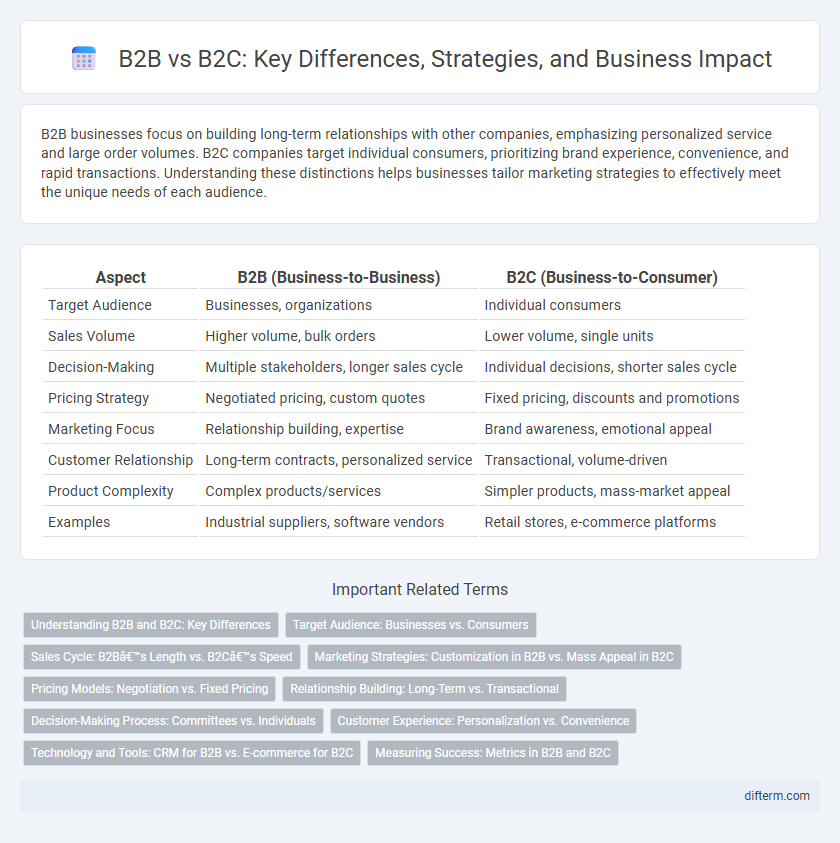B2B businesses focus on building long-term relationships with other companies, emphasizing personalized service and large order volumes. B2C companies target individual consumers, prioritizing brand experience, convenience, and rapid transactions. Understanding these distinctions helps businesses tailor marketing strategies to effectively meet the unique needs of each audience.
Table of Comparison
| Aspect | B2B (Business-to-Business) | B2C (Business-to-Consumer) |
|---|---|---|
| Target Audience | Businesses, organizations | Individual consumers |
| Sales Volume | Higher volume, bulk orders | Lower volume, single units |
| Decision-Making | Multiple stakeholders, longer sales cycle | Individual decisions, shorter sales cycle |
| Pricing Strategy | Negotiated pricing, custom quotes | Fixed pricing, discounts and promotions |
| Marketing Focus | Relationship building, expertise | Brand awareness, emotional appeal |
| Customer Relationship | Long-term contracts, personalized service | Transactional, volume-driven |
| Product Complexity | Complex products/services | Simpler products, mass-market appeal |
| Examples | Industrial suppliers, software vendors | Retail stores, e-commerce platforms |
Understanding B2B and B2C: Key Differences
B2B (Business-to-Business) transactions involve companies selling products or services directly to other businesses, emphasizing longer sales cycles, larger order volumes, and relationship-driven interactions. B2C (Business-to-Consumer) focuses on selling directly to individual customers, prioritizing quick decision-making, emotional appeal, and high-volume, lower-value sales. Understanding these distinctions helps businesses tailor marketing strategies, customer engagement, and sales processes to effectively reach their target audience.
Target Audience: Businesses vs. Consumers
B2B marketing targets businesses by addressing their specific operational needs, decision-making processes, and long-term value, often involving multiple stakeholders. B2C marketing focuses on individual consumers, emphasizing emotional appeal, quick purchasing decisions, and personal benefits. Understanding these distinct target audiences is crucial for tailoring marketing strategies that drive engagement and conversions effectively.
Sales Cycle: B2B’s Length vs. B2C’s Speed
B2B sales cycles typically extend over weeks or months due to complex decision-making processes, multiple stakeholders, and higher transaction values. In contrast, B2C sales cycles are much shorter, often completed within minutes or days, driven by individual consumer decisions and lower purchase risks. Understanding these differences is crucial for developing tailored marketing strategies that align with customer behavior and sales objectives in each market.
Marketing Strategies: Customization in B2B vs. Mass Appeal in B2C
B2B marketing strategies emphasize customization, tailoring solutions to meet specific client needs, often involving personalized communication and relationship-building to drive long-term engagement. In contrast, B2C marketing focuses on mass appeal, leveraging broad-based campaigns, emotional triggers, and wide-reaching channels to attract diverse consumer groups. Data-driven insights and customer segmentation play crucial roles in optimizing both approaches for maximum impact in their respective markets.
Pricing Models: Negotiation vs. Fixed Pricing
B2B pricing models often emphasize negotiation, enabling customized quotes based on volume, long-term contracts, and specific client needs, which fosters flexibility and relationship-building. In contrast, B2C pricing typically relies on fixed pricing structures, offering standardized prices for products or services to streamline purchasing decisions and enhance transparency. Understanding these differences is vital for businesses aiming to optimize revenue strategies and customer satisfaction across different market segments.
Relationship Building: Long-Term vs. Transactional
B2B relationship building emphasizes long-term partnerships driven by trust, collaboration, and ongoing value creation, often involving personalized communication and tailored solutions. In contrast, B2C interactions tend to be more transactional, focusing on immediate customer satisfaction, convenience, and quick decision-making processes. Businesses in B2B markets invest heavily in nurturing client relationships through continuous engagement and after-sales support to ensure sustained loyalty and recurring revenue.
Decision-Making Process: Committees vs. Individuals
B2B decision-making processes typically involve multiple stakeholders and committees that evaluate purchases based on detailed criteria, budgets, and long-term ROI, reflecting organizational priorities. In contrast, B2C decisions are generally made by individuals or households, driven by personal preferences, emotional factors, and immediate benefits. Understanding the complexity and length of B2B purchasing cycles versus the faster, more impulsive nature of B2C decisions is crucial for tailoring marketing strategies effectively.
Customer Experience: Personalization vs. Convenience
B2B customer experience prioritizes personalization through tailored solutions, account management, and detailed communication to meet specific business needs. B2C emphasizes convenience by streamlining purchasing processes, offering fast delivery, and providing user-friendly interfaces for seamless shopping. Both approaches optimize customer satisfaction but differ in delivering value aligned with client expectations and decision-making complexity.
Technology and Tools: CRM for B2B vs. E-commerce for B2C
B2B businesses rely heavily on Customer Relationship Management (CRM) systems to manage complex sales cycles, track client interactions, and nurture long-term partnerships. In contrast, B2C companies prioritize e-commerce platforms optimized for high-volume transactions, user-friendly interfaces, and seamless payment processing to enhance customer experience. Both sectors utilize data analytics, but CRM tools in B2B focus on lead scoring and account management, while B2C e-commerce leverages personalization algorithms and targeted marketing campaigns.
Measuring Success: Metrics in B2B and B2C
B2B success metrics prioritize long-term client relationships, measuring customer lifetime value, lead conversion rates, and sales cycle length, reflecting complex decision-making processes. In B2C, success hinges on metrics like customer acquisition cost, retention rates, and average transaction value, emphasizing volume and repeat purchases. Both models use net promoter scores and customer satisfaction to gauge loyalty, but strategic focus differs due to market dynamics and purchase behavior.
B2B vs B2C Infographic

 difterm.com
difterm.com